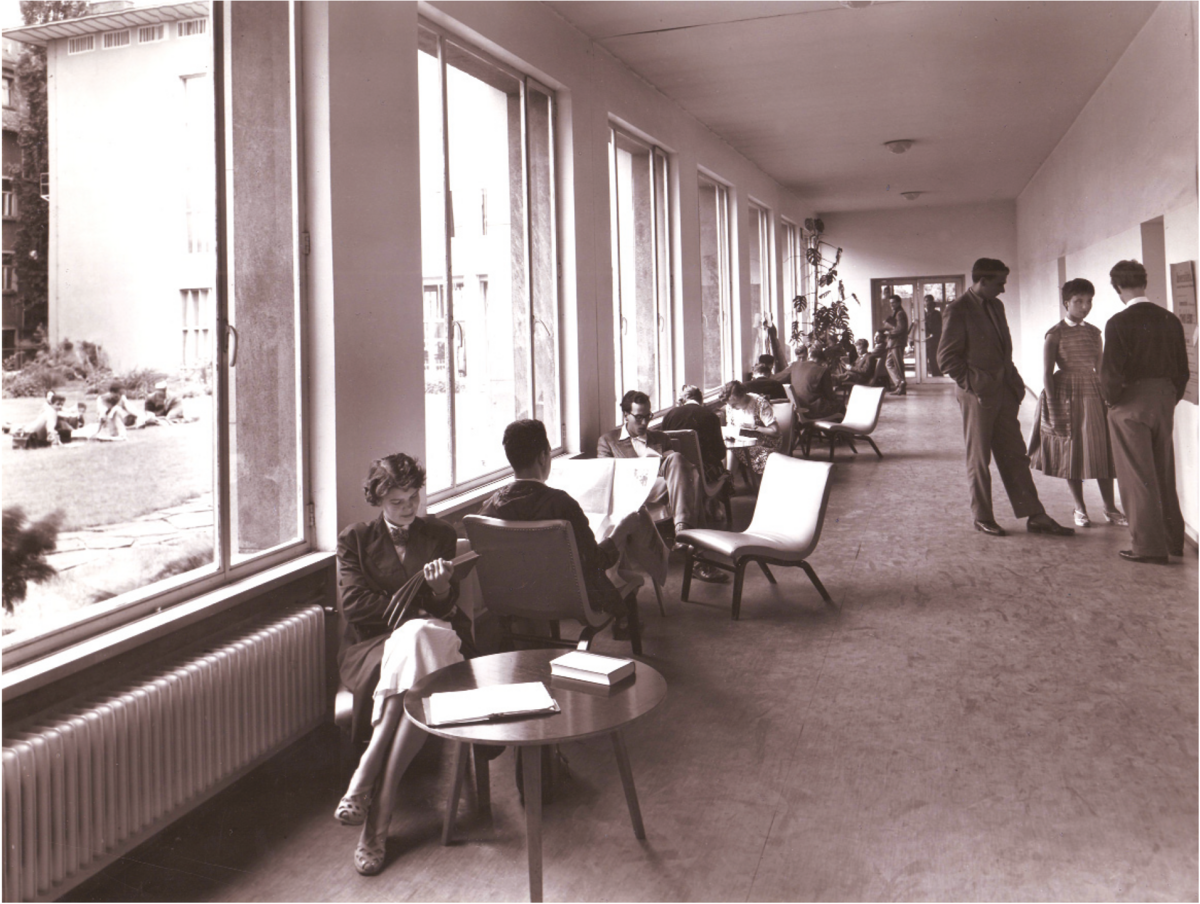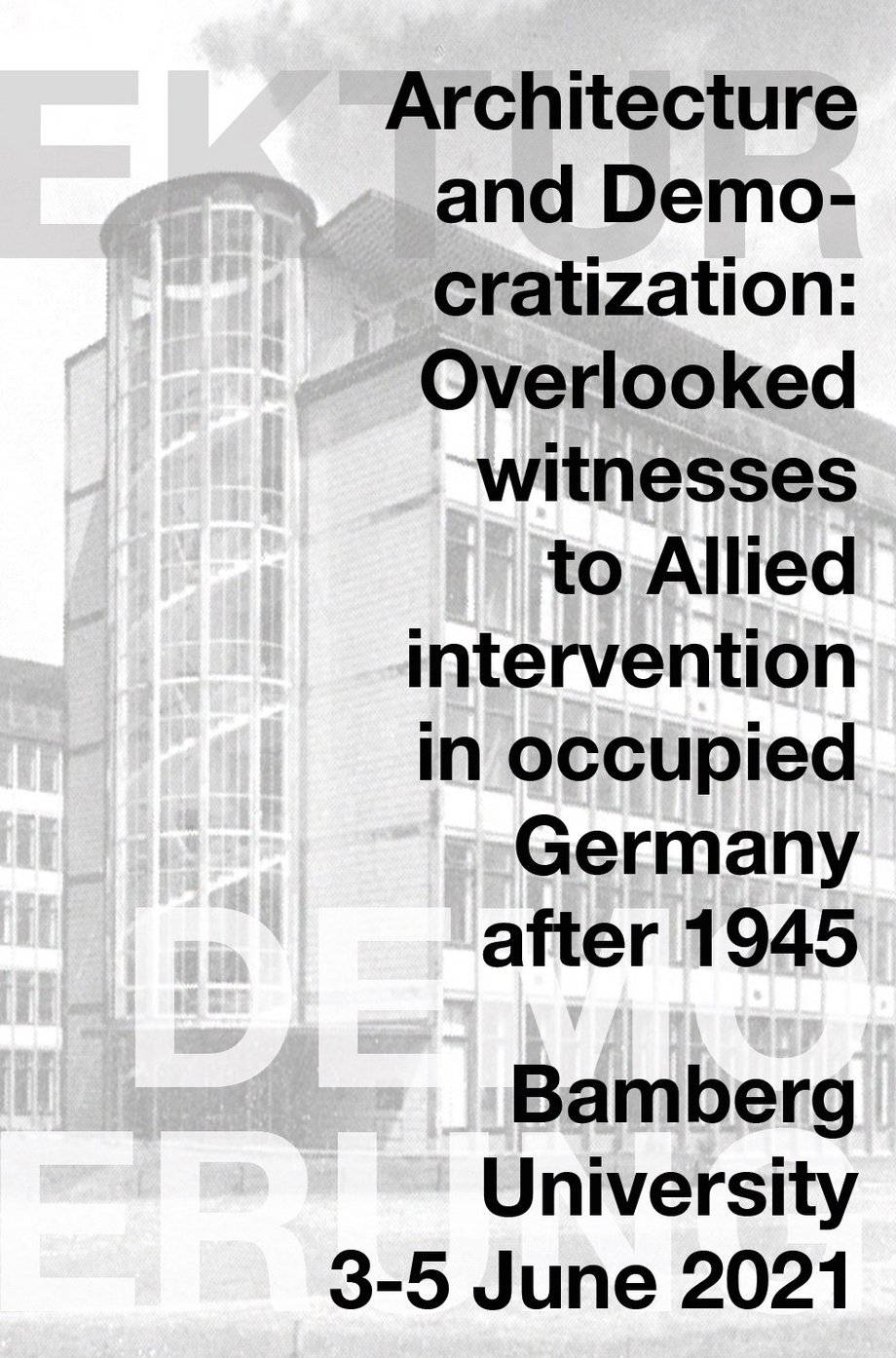Architecture and Democratization Overlooked witnesses to Allied intervention in occupied Germany after 1945

In 2019 and 2020, Germany marked 70 years since its post-war division into East and West and 30 years since reunification. Both anniversaries offer renewed occasion to examine the processes that led to the creation of the two German states in 1949, together with the premises on which they were founded and which seemed vindicated in 1990: premises such as the inevitability of democracy, the value of internationalism, and the possibility of a peaceful and stable world order. Given the current questioning of these ideas not only here but throughout Europe and beyond, such a re-examination seems relevant now in a way that it has rarely been before.
Architecture, too, must be part of this discussion. Both the Federal Republic of Germany and the German Democratic Republic were visions of a new, different and better Germany that was to be realized in part through planning and building. The rehabilitation of the country in the wake of Nazism and total war – the reform of its political and social systems, the retooling of its economy, and not least the reorientation of its population toward the values of democracy as variously defined – was to be reflected both literally and figuratively in the fabric of its rebuilt cities.
While this work was largely accomplished by Germans themselves, it was also very much an international project, one promoted and supervised by the occupying Allied powers. By supporting certain German initiatives in the area of building, by offering their own cities and structures as models and providing opportunities for knowledge exchange, and by committing significant financial, material and intellectual resources to democracy-promoting projects and programs that included a building or planning dimension, the military and civilian authorities of the United States, Britain, France and the Soviet Union sought to shape the character of German reconstruction in line with their respective ideological and political goals.
The legacy of this effort endures in the landscape of post-reunification Germany today. Events such as the 2009 Berlin exhibition "Geschenke der Amerikaner" (Gifts from the Americans)1 periodically recall them to mind; in that context as in others, however, it is generally only the most overt expressions of ideology and the acknowledged design highlights that receive attention. Meanwhile, the vast majority of Allied interventions in Germany's built environment – those that were to accomplish the main work of the democratization effort – continue to be overlooked. In fact, the country's built landscape on both sides of its internal border, and well beyond the confines of Berlin, is punctuated with structures bearing witness in both more and less immediately visible ways to the occupation powers' attempts to forge durable, supranational communities of value and interest around the malleable concept of democracy.
International Conference "Architecture and Democratization", 3-5 June 2021 at Bamberg University / online
The conference "Architecture and Democratization" aimed to address this oversight. Encouraged by parallel efforts in Austria2, and taking seriously the notion that "Democracy must be made visible if it is to be understood and embraced"3, the first goal of the conference was to call attention to forgotten or neglected artefacts of Western and Soviet cultural-political intervention in Germany's built environment, with a view to creating a broader as well as a more detailed picture of this activity.
An area of particular focus concerned the value of this architectural legacy of the past as a source of insights for the present – both as a set of responses to an earlier crisis of democracy, and as one of the means by which those responses became solidified as part of the seemingly permanent structure of the post-war world. The aim was to create a basis for conserving and presenting this historical resource – by no means solid or permanent after all, but evidently quite vulnerable and fragile – and thus ensure that it is visible and accessible to current and future generations.
Conference publication "Architecture and Democratization" - in preparation
The conference proceedings are being prepared for publication. The contributions in German and English will be complemented by additional texts by recognized experts from the fields of history, cultural studies, political science and heritage studies.
Publications and lectures associated with the project
Article: Johanna Blokker, "Was nach dem Kalten Krieg übrig bleibt. Umnutzung und Umdeutung der gebauten Hinterlassenschaften der amerikanischen Präsenz in Deutschland", in: Strukturwandel – Denkmalwandel. Umbau, Umnutzung, Umdeutung. Veröffentlichungen des AKTLD 25, ed. Birgit Franz and Ingrid Scheurmann (Holzminden, 2016), pp. 114-121
Lecture: "Konversion und Konservierung: Der Erinnerungswert ehemaliger Militärstützpunkte und die Möglichkeiten seiner Erhaltung und Realisierung", Workshop Ehemalige militärische Liegenschaften im urbanen Raum – Konversion für die Zukunftsstadt?, Bonn International Centre for Conversion (BICC), 2015
Lecture: "Was nach dem Kalten Krieg übrig bleibt. Umnutzung und Umdeutung der gebauten Hinterlassenschaften der amerikanischen Präsenz in Deutschland nach 1989", Strukturwandel – Denkmalwandel. Umdeutung, Umnutzung, Umbau, annual conference of the Working Group on Theory and Education in Heritage Conservation (AKTLD), Dortmund, 2015
Lecture: "Germany's Amerika-Häuser: Architecture in the Battle for Hearts and Minds", lecture series Making America, Lehrstuhl für Amerikanistik, Bamberg University, 2015
Research-led teaching
Seminar Konversion und Konservierung: Ehemalige Militärstützpunkte und die Erhaltung ihrer Erinnerungswerte, Master's Program in Heritage Conservation, Bamberg University, Summer Semester 2020.
Seminar Wiederaufbau nach beiden Weltkriegen in Deutschland und Europa, Master's Program in Heritage Conservation, Bamberg University, Winter Semester 2012-13, 2017-18, 2019-20.
Seminar Denkmalpflege und Politik - Denkmalpflege als Politik, Master's Program in Heritage Conservation, Bamberg University, Winter Semester 2017-18, 2019-20.
Seminar Schöne neue Welt: Internationale Beiträge zum Wiederaufbau in Deutschland nach 1945, Master's Program in Heritage Conservation, Bamberg University, Winter Semester 2014-15.
Seminar Denkmalkulturen International, Master's Program in Heritage Conservation, Bamberg University, Winter Semester 2012-13, Summer Semester 2015.
Project lead:
Prof. Johanna M. Blokker
Chair in Architectural Conservation
Institute of Construction History and Art History
Brandenburg Technical University Cottbus-Senftenberg
Building 2B, Room 0.12
Konrad-Wachsmann-Allee 4
03044 Cottbus
Tel: ++49 355 69 3992
Tel: ++49 355 69 3117 (departmental office)
E-mail: Johanna.Blokker(at)b-tu.de
1 Geschenke der Amerikaner, 09.05. bis 30.06.2009 im Amerika-Haus Berlin, heute Sitz der Stiftung C/O Berlin.
2 Kalter Krieg und Architektur. Beiträge zur Demokratisierung Österreichs nach 1945, 17.10.2019 bis 24.02.2020 im Architekturzentrum Wien.
3 Michael Dreyer, Vorsitzender des Vereins Weimarer Republik e.V., auf dem Symposion Die Frankfurter Paulskirche. Ort der deutschen Demokratie, Frankfurt a.M., 30.09. bis 01.10.2019.

